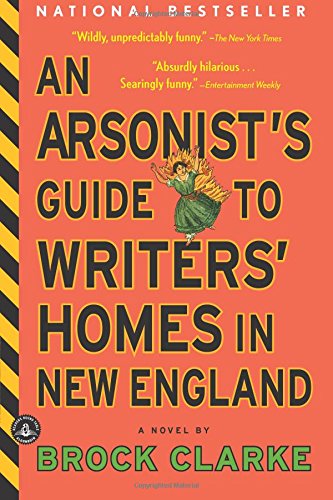Eighty pages into this, his second novel, Brock Clarke takes a seeming swipe at his first. His narrator, Sam Pulsifer, is wandering through a bookstore when he begins to feel bad for fiction and poetry, those “obsolete states” that have been “mostly gobbled up” by the store’s memoir section, “the Soviet Union of literature.” Sam picks up The Ordinary White Boy—Clarke’s first novel—since he too had “been an ordinary white boy once, before the killing and burning.” But he finds that the novel is not very different from the memoirs, and he decides “never again to feel sorry for the fiction section, the way you stopped feeling sorry for Lithuania once it rolled over so easily and started speaking Russian so soon after being annexed.”
About that “killing and burning”: Sam, at eighteen, accidentally burned down the Emily Dickinson House in Amherst, Massachusetts, killing two people. After ten years in prison, he forged a new life in Springfield, about a half hour and a world away from the Volvos and dormitories of his Massachussets hometown. He put away literary things, along with the rest of his past. But at the beginning of An Arsonist’s Guide, Sam’s wife, oblivious to this history, prompts a move to Amherst, where literature and family and past incarceration catch up to him all at once.
And so Sam finds himself a bumbling detective, attempting to discover who has begun burning down writers’ homes and leaving him to take the blame. To solve this mystery, Sam decides he must understand why people read—hence his visit to the bookstore with the enormous memoir section. Hence also Clarke’s steady satirizing of contemporary literary life: the book club in which “the book was there to give the women (mostly) a reason to confess to the feelings they’d already had before reading the book”; the literature professor who doesn’t like literature and thinks “all writers are cunts”; the famous writer whose early books are “populated by taciturn northern New Hampshire countrymen with violent tendencies” and which show “how the harsh northern New Hampshire landscape is part and parcel of that violence,” and whose later books are set in Wyoming, “where the men are also taciturn and violent, et cetera.”
Clarke squarely lands each of these jabs—and then proceeds to dance around his targets, rather than pummeling them further. In his 2006 essay “The Novel Is Dead, Long Live the Novel,” Clarke wrote that “a novel is a novel not because...
You have reached your article limit
Sign up for a digital subscription and continue reading all new issues, plus our entire archives, for just $1.50/month.
Already a subscriber? Sign in





